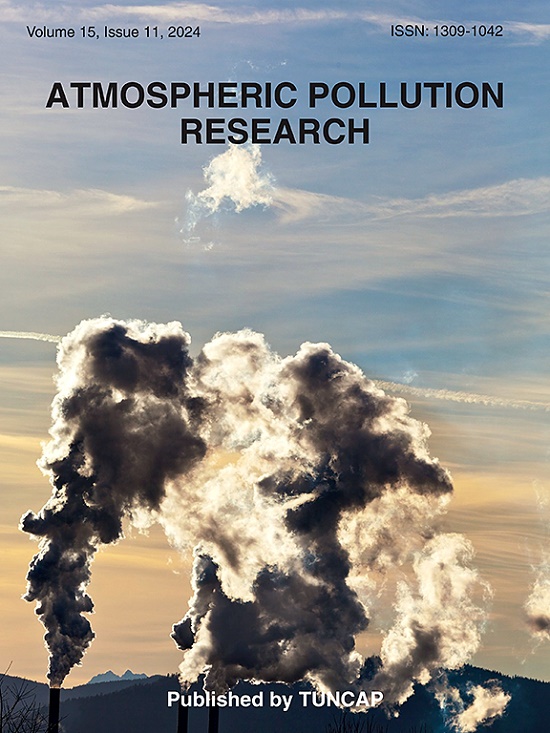2019冠状病毒病大流行之前和期间罹患心血管疾病的3年癌症幸存者的短期PM2.5暴露
IF 3.5
3区 环境科学与生态学
Q2 ENVIRONMENTAL SCIENCES
引用次数: 0
摘要
可吸入颗粒物(PM2.5)暴露与癌症幸存者心血管疾病(CVD)发展有关。在2019冠状病毒病大流行期间,PM2.5浓度水平表现出时间变异性,这可能导致了对人群健康的不同影响。本研究的目的是探讨在COVID-19之前和期间PM2.5暴露的变化与癌症幸存者中心血管疾病的发病率之间的关系。利用国民健康保险公团的大数据,提取了2009 ~ 2018年诊断为3年癌症的幸存者和2015年以后新患心血管疾病的患者。在时间分层病例交叉设计中,采用条件logistic模型分析PM2.5短期暴露与心血管疾病发病率的关系。收集了39,581名患心血管疾病的癌症幸存者。在covid - 19社交距离之前,PM2.5水平升高与心血管疾病风险增加相关(滞后0 or 1.030, 95% CI 1.014-1.046;滞后0-1 (or 1.027, 95% CI 1.009-1.045)。另一方面,在2019冠状病毒病期间,室外暴露PM2.5与癌症幸存者心血管疾病发病率之间的相关性消失(滞后0 aOR 0.998, 95% CI 0.916-1.087;滞后0-1 (or 1.001, 95% CI 0.971-1.032)。本研究旨在探讨大流行前和COVID-19大流行期间癌症幸存者PM2.5暴露变异性与心血管疾病发病率之间的关系。需要进一步的研究来阐明机制途径,并建立PM2.5暴露波动对癌症幸存者心血管后果的因果关系。本文章由计算机程序翻译,如有差异,请以英文原文为准。
Short-term PM2.5 exposure among 3-year cancer survivors with incident cardiovascular disease before and during the COVID-19 pandemic period
Particulate matter (PM2.5) exposure is suggested to the development of cardiovascular disease (CVD) in cancer survivors. During the COVID-19 pandemic, PM2.5 concentration levels exhibited temporal variability, which may have contributed to differential health impacts on populations. The purpose of this study is to explore the association between the variance in PM2.5 exposure prior to and during the COVID-19 period and the incidence of CVD among cancer survivors. Utilizing big data from the Korea National Health Insurance Service, three-year cancer survivors diagnosed between 2009 and 2018 and new CVD event after 2015 were extracted. The association between short-term exposure PM2.5 and the incidence of CVD was analyzed by using the conditional logistic model in the design of time-stratified case-crossover. 39,581 cancer survivors who developed CVD were collected. Elevated levels of PM2.5 were associated with increased CVD risk before COVID19 social distancing (lag 0 aOR 1.030, 95 % CI 1.014–1.046; lag 0–1 aOR 1.027, 95 % CI 1.009–1.045). On the other hand, the association between outdoors exposure of PM2.5 and the incidence of CVD disappeared in cancer survivors during COVID19 period (lag 0 aOR 0.998, 95 % CI 0.916–1.087; lag 0–1 aOR 1.001, 95 % CI 0.971–1.032). This study aims to investigate the association between PM2.5 exposure variability and CVD incidence among cancer survivors during the pre-pandemic and COVID-19 pandemic periods. Further research is required to elucidate the mechanistic pathways and establish causal relationships underlying the cardiovascular consequences of PM2.5 exposure fluctuations in cancer survivor.
求助全文
通过发布文献求助,成功后即可免费获取论文全文。
去求助
来源期刊

Atmospheric Pollution Research
ENVIRONMENTAL SCIENCES-
CiteScore
8.30
自引率
6.70%
发文量
256
审稿时长
36 days
期刊介绍:
Atmospheric Pollution Research (APR) is an international journal designed for the publication of articles on air pollution. Papers should present novel experimental results, theory and modeling of air pollution on local, regional, or global scales. Areas covered are research on inorganic, organic, and persistent organic air pollutants, air quality monitoring, air quality management, atmospheric dispersion and transport, air-surface (soil, water, and vegetation) exchange of pollutants, dry and wet deposition, indoor air quality, exposure assessment, health effects, satellite measurements, natural emissions, atmospheric chemistry, greenhouse gases, and effects on climate change.
 求助内容:
求助内容: 应助结果提醒方式:
应助结果提醒方式:


